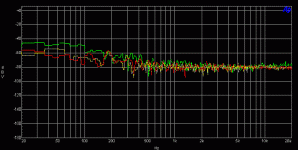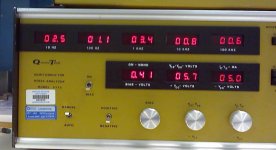Before I discuss metal purity and its implications, I might again point out that two separate areas of cable optimization are possible. There is material purity and quality, and the other is geometric configurations. Geometric configurations have been around since the late '70's and started with Litz wire twin pairs or by special winding configurations to change the arrival time between the high and low frequencies (Bruce Brisson).
For example, Mendota Research used Litz wire as the primary and return connector, put clear Teflon tubing around each conductor, then put both Teflon covered Litz wire leads in a copper shield, and attached quality connectors to each end. This allowed that the shield be completely separate from the ground return wire. We tried these for a few years, and sent samples to Harry Pearson at 'The Absolute Sound'. The best recommendation that I got was that Harry wanted more, if possible, for his audio system. That is a true recommendation, as he had so many other choices at the time. If anything, these cables sounded better, if slightly 'tizzy'. Still they were my choice for many years.
The other geometry used a dual spiral winding on a non-magnetic former with the large wire on the inside and the small wire on the outside. While this can seem confusing, it actually becomes a 'reverse' equilizer of sorts, removing accumulated nonlinear delay. At least, I think that is the way it works. I can give some other examples, later.
In either case, skin effect is very important for the effectiveness of either geometry.
For example, Mendota Research used Litz wire as the primary and return connector, put clear Teflon tubing around each conductor, then put both Teflon covered Litz wire leads in a copper shield, and attached quality connectors to each end. This allowed that the shield be completely separate from the ground return wire. We tried these for a few years, and sent samples to Harry Pearson at 'The Absolute Sound'. The best recommendation that I got was that Harry wanted more, if possible, for his audio system. That is a true recommendation, as he had so many other choices at the time. If anything, these cables sounded better, if slightly 'tizzy'. Still they were my choice for many years.
The other geometry used a dual spiral winding on a non-magnetic former with the large wire on the inside and the small wire on the outside. While this can seem confusing, it actually becomes a 'reverse' equilizer of sorts, removing accumulated nonlinear delay. At least, I think that is the way it works. I can give some other examples, later.
In either case, skin effect is very important for the effectiveness of either geometry.
My personal opinion is that the case for skin effect and audio is highly overstated. Hawksford's study for one has been discredited by at least one person whose expertise is more suited to the problem. Mathematical results at this level of sophistication are easily misinterpreted.
Now I would like to bring up a few points that I uncovered while looking through some books on electron flow in metals:
I had heard of different conductivity of various offerings of copper due to purity or annealing, but I had no real understanding of it at first.
Appearently it is easy to bring out these differences, that seem so subtle at room temperature, at very low temperatures. Then, different copper samples can measure quite differently from what would be expected at room temperature. It is a bit like what we do when we are measuring THD in circuits. You might say that the room temperature measurement is much like looking at a sinewave passing through a component on an oscilloscope. Unless you are clipping or have really high crossover distortion, you won't be able to tell the difference between components by just looking at the oscilloscope only. However, IF you should 'notch out' the test sine wave, and then look at the results on the oscilloscope, you will find lots of extra stuff (distortion) that is what makes components sound different. Virtually all techs and engineers when measuring THD, have looked at both the raw output signal and the 'notched signal' at the same time on a dual input oscilloscope. An FFT is another way of measurement, and is not what we are discussing here.
Well, super cooling a piece of copper or any other metal does much the same thing. Once you remove the fundamental resistance mechanism, you are left with a 'residual'. It is the 'residual' that I would like to address in future comments, and what contributes to it.
I had heard of different conductivity of various offerings of copper due to purity or annealing, but I had no real understanding of it at first.
Appearently it is easy to bring out these differences, that seem so subtle at room temperature, at very low temperatures. Then, different copper samples can measure quite differently from what would be expected at room temperature. It is a bit like what we do when we are measuring THD in circuits. You might say that the room temperature measurement is much like looking at a sinewave passing through a component on an oscilloscope. Unless you are clipping or have really high crossover distortion, you won't be able to tell the difference between components by just looking at the oscilloscope only. However, IF you should 'notch out' the test sine wave, and then look at the results on the oscilloscope, you will find lots of extra stuff (distortion) that is what makes components sound different. Virtually all techs and engineers when measuring THD, have looked at both the raw output signal and the 'notched signal' at the same time on a dual input oscilloscope. An FFT is another way of measurement, and is not what we are discussing here.
Well, super cooling a piece of copper or any other metal does much the same thing. Once you remove the fundamental resistance mechanism, you are left with a 'residual'. It is the 'residual' that I would like to address in future comments, and what contributes to it.
Just checked, BF862 has very bad 1/f noise in reality. 80nV/rt.Hz cited at 10 Hz.
green is BF862
Attachments
Scott, you proceed this comentary. The mechanisms that cause 'skin effect' in my two examples, have nothing to do with Dr. Hawksford's work. You would do well by reading Dr. Hawksford's commentary, rather than relying on others. I have known Dr. Hawksford for about 25 years, and have had him over at my office. I was the one who contacted him when he was being blindsided by your associate, and I have read the correspondance between them. I also spoke to Dr. Hawksford after the discussion of his work had died down. He stands by his original statements, and I will give him the benefit-of-doubt, since he is a full professor, has looked at the criticism by others, and stands by his work.
Dimitri, an associate of mine also measured the BF862 and found it fairly quiet. He used a calibrated Quan-Tech and I trust his results, also. It may be batch dependent. That is something that I worried about, initally. The manufacturer does NOT promise or even rate low frequency noise on the spec sheet.
dimitri said:
green is BF862
Dimitri your plots only go down to 20Hz and the last 1/2 a decade is flat. You really need a Quantec or something with more spectral resolution at the low end.
John is right, there is no guarantee but this is like the 2N4401 a designer "secret". A large portion of the population is 2.5 nV at 10Hz (see picture) you just need to sort (and they are cheap). The general feeling is that even the LSK170's fail noise for some batches.
EDIT - note our Quan-Tech is leaking some of the 1kHz calibration tone during the measurement, I'm probably the only person who knows this.
Attachments
A bit OT maybe, but a Quan-Tech is for sale on eBay for $99 at the moment.
http://cgi.ebay.com/Quan-Tech-2181/...ItemQQimsxZ20081030?IMSfp=TL081030114001r2757
http://cgi.ebay.com/Quan-Tech-2181/...ItemQQimsxZ20081030?IMSfp=TL081030114001r2757
Hawksford's article on field propagation inside the cable is here:
http://www.essex.ac.uk/dces/research/audio_lab/malcolmspubdocs/G31 Essex echo 1995.pdf
and it is really not about skin effect only. I assume we can discuss it after having read it.
http://www.essex.ac.uk/dces/research/audio_lab/malcolmspubdocs/G31 Essex echo 1995.pdf
and it is really not about skin effect only. I assume we can discuss it after having read it.
PMA said:Hawksford's article on field propagation inside the cable is here:
http://www.essex.ac.uk/dces/research/audio_lab/malcolmspubdocs/G31 Essex echo 1995.pdf
and it is really not about skin effect only. I assume we can discuss it after having read it.
To be fair there are few here that can critique the math. My first comment involves a typical sleight of hand in audio circles. A suddenly ended sine pulse is a non band-limited signal the interpretation of the "time smear" as some delayed signal or "memory" effect is questionable. The exercise of modling the same line as a lumped RLC and observing the result is not carried out.
scott wurcer said:
To be fair there are few here that can critique the math. My first comment involves a typical sleight of hand in audio circles. A suddenly ended sine pulse is a non band-limited signal the interpretation of the "time smear" as some delayed signal or "memory" effect is questionable. The exercise of modling the same line as a lumped RLC and observing the result is not carried out.
As much as I respect Prof. Hawksford for his pioneering work in other areas, in this paper he screwed it royally. Long story short: his math is entirely correct and is at the junior EE level. However the conclusions he is drawing are rubbish. Here's a throughout analysis I couldn't agree more with:
http://www.theaudiocritic.com/back_issues/The_Audio_Critic_24_r.pdf pp. 75
It would be interesting to figure out why this paper was never submitted to a peer review journal. I can't find any valid reason why this piece of junk was submitted for publication, even in Stereophile. It certainly did not much good for his reputation.
BTW, measurements and comparisons to RLC models are in
http://www.essex.ac.uk/dces/research/audio_lab/malcolmspubdocs/G6-9 Unification (4 parts).pdf
http://www.essex.ac.uk/dces/research/audio_lab/malcolmspubdocs/G6-9 Unification (4 parts).pdf
- Status
- Not open for further replies.
- Home
- Amplifiers
- Solid State
- John Curl's Blowtorch preamplifier

